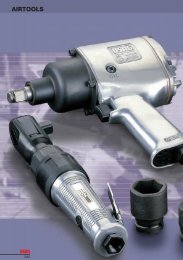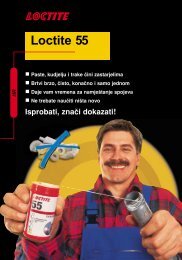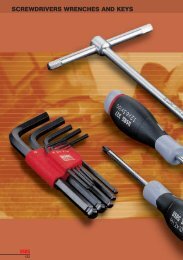Industrial seal self study guide - SKF.com
Industrial seal self study guide - SKF.com
Industrial seal self study guide - SKF.com
Create successful ePaper yourself
Turn your PDF publications into a flip-book with our unique Google optimized e-Paper software.
Glossary of Seal Terms<br />
Abrasives – Materials that cause wear,<br />
friction or irritation<br />
All-Rubber Seals – A non-metal clad <strong>seal</strong> made of<br />
rubber <strong>com</strong>monly used where space limitation and<br />
installation difficulties are a major consideration.<br />
Two basic types of HS all-rubber <strong>seal</strong>s are solid<br />
and split, both require a cover plate for proper<br />
<strong>com</strong>pression and <strong>seal</strong>ing.<br />
Auxiliary Lip – See Secondary Lip<br />
Axial Seal – Applies force along the direction of<br />
the shaft, usually between one moving and one<br />
stationary element. Examples: carbon<br />
face <strong>seal</strong>, V-Ring.<br />
Axial Clamp Split Seal – Made of nitrile, these<br />
<strong>com</strong>pact <strong>seal</strong>s operate against a rotating step or roll<br />
face. Re<strong>com</strong>mended for large diameter applications<br />
where there is the need for a second <strong>seal</strong> to<br />
exclude dirt.<br />
Bearing – An anti-friction device that supports,<br />
<strong>guide</strong>s, and reduces friction between fixed and<br />
moving machine parts. Rolling bearings rely on<br />
balls or roller elements riding within raceways on<br />
a thin film of lubricant. Plane or sleeve bearings<br />
use only a lubricant film.<br />
Bi-rotational Seal – A rotary shaft <strong>seal</strong> which will<br />
<strong>seal</strong> fluid regardless of direction of shaft rotation.<br />
Bond – The adhesion established by vulcanization<br />
between two cured elastomer surfaces, or between<br />
one cured elastomer surface and one<br />
non-elastomer surface.<br />
Bonded Seal – Design feature of a type of radial<br />
lip <strong>seal</strong>. The heel of the <strong>seal</strong>ing element is attached<br />
(bonded) to the <strong>seal</strong> case by an adhesive during the<br />
molding operation.<br />
Bore – See Seal Bore.<br />
Bore-tite – A <strong>seal</strong>ant that fills small bore<br />
imperfections.<br />
Bottom Out – Installation of a <strong>seal</strong> into a groove<br />
until it reaches the end of possible travel. Additional<br />
force should not be used or damage can result.<br />
Buna-N – See nitrile.<br />
Burr – A rough edge on metal or other material<br />
after it has been cast, cut, or drilled.<br />
Case, Bonded – A design feature of a type of radial<br />
lip <strong>seal</strong> wherein the heel of the <strong>seal</strong>ing element is<br />
attached to the <strong>seal</strong> case by an adhesive during the<br />
molding operation.<br />
Case, Inner – A rigid, cup-shaped <strong>com</strong>ponent of a<br />
<strong>seal</strong> assembly, which is placed inside the outer <strong>seal</strong><br />
case.<br />
Case, Outer – The outer thin-wall rigid structure of<br />
the lip-<strong>seal</strong> assembly which contains the inner case,<br />
the primary-<strong>seal</strong> ring, the spring parts, and the<br />
secondary <strong>seal</strong>.<br />
Case, Seal – A rigid member to which the <strong>seal</strong> lip<br />
is attached.<br />
Case Width – The total axial width of the <strong>seal</strong> case.<br />
Cavity, Mold – A single unit or assembly of<br />
contoured parts in which a material, such as an<br />
elastomer, is shaped into a particular configuration.<br />
Cavity, Seal – The annular area between a housing<br />
bore and a shaft, into which a <strong>seal</strong> is installed.<br />
Chamfer – A surface that has a groove cut in it or<br />
the edge or corner is cut off; beveled.<br />
Cocked – An installation in which the plane of the<br />
outside <strong>seal</strong> face is not perpendicular to the shaft<br />
axis.<br />
Compound – A substance or material formed<br />
by the <strong>com</strong>bination of two or more otherwise<br />
independent elements.<br />
Contaminants – Foreign matter on the <strong>seal</strong><br />
surface.<br />
Contact Pressure – The average pressure exerted<br />
by a <strong>seal</strong> on a shaft. This pressure is <strong>com</strong>puted<br />
dividing the total lip force by the total lip area. Also<br />
referred to as radial load.<br />
Counterface – The end of a bearing, a washer, a<br />
steel stamping, or even the back of an oil <strong>seal</strong> shell.<br />
Cover Plate – Metal plate used to <strong>com</strong>press all<br />
rubber (HS) <strong>seal</strong>s in the bore and hold them<br />
securely. 87<br />
i







